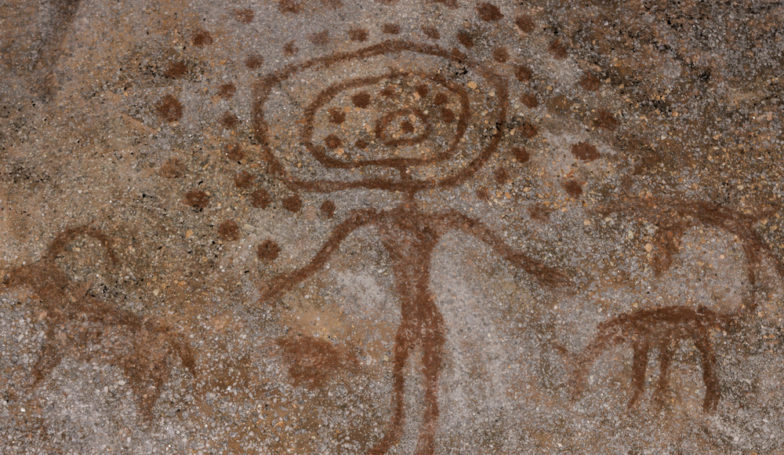Intuitive Knowledge and the Image of God, Part 2 of 4
A recent study determined that many people display a purely intuitive resistance to biological evolution. An alternate paradigm—God’s image in every human—accounts for this resistance by explaining that we are able to perceive creation’s “testimony” to the Creator’s existence (Psalm 19:1–4; Romans 1:18–20). Part 2 of this series more precisely defines and characterizes this testimony.
In part 1 of this series, I described recent work1 that examined reasons for the resistance that many people display towards biological evolution2 as an adequate explanation for life’s origin and diversity. The researchers found that the greatest resistance was due to a “feeling of uncertainty,” an intuitive (gut) feeling that evolution was not true.3 I then considered an alternate paradigm, that these intuitive feelings against Darwinism arise from God’s image in man (Genesis 1:26–27). His image or likeness within human beings enables us to be receptive to the “testimony” of His existence through creation, as indicated in Psalm 19:1–4, Isaiah 40:26, Romans 1:18–20, and in other verses.4
A Layperson’s Perspective of the Creator’s Testimony
In fact, the researchers themselves referenced a study that came to the conclusion that children “generate intuitive creationist beliefs about origins.”5 Because of God’s image, not only do children generate such beliefs; many adults do as well. Hence, an informed layperson can draw the following inferences:
- The universe had to come from something or Someone, not nothing or no one.6
- The universe is not a chaotic mess; it’s ordered and structured and manifests intricate complexity even on a subatomic scale. Moreover, this complexity appears to be designed to allow for the existence of living organisms.7 Thus, the universe likely arose from an intelligent Cause.
- The complex but integrated anatomies and physiologies of humans, animals, and plants reflect the intelligence, forethought, and craftsmanship of a Creator.8
Scientific Confirmations
These inferences are confirmed by several lines of evidence, including (1) the beginning of the universe in the relatively-recent, finite past (13.7 billion years ago; implying a transcendent, personal, and extremely-powerful Beginner);9 (2) the fine-tuning of the cosmos (implying an ingenious and purposeful Fine-Tuner);10 (3) the rationality, mathematical precision, and elegance of the laws of physics (implying an intelligent and rational Creator),11 and (4) the exquisite design of intracellular molecular machines—which are, in many instances, structural and functional analogs to man-made machines (implying a knowledgeable and clever Designer).12 In addition, many other intracellular biochemical systems give the distinct impression of being intelligently designed.13
Such evidences have prompted reputable scientists to make surprising acknowledgements:
- Physicist Stephen Hawking: “It would be very difficult to explain why the universe should have begun in just this way, except as the act of a God who intended to create beings like us.”14
- Astronomer Fred Hoyle: “… a superintellect has monkeyed with physics, as well as with chemistry and biology.”15
- Physicist Paul Davies: “[There] is for me powerful evidence that there is something going on behind it all… It seems as though somebody has fine-tuned nature’s numbers to make the Universe… The impression of design is overwhelming.”16
- Cosmologist Edward Harrison: “Here is the cosmological proof of the existence of God—the design argument of Paley—updated and refurbished. The fine-tuning of the universe provides prima facie evidence of deistic design. Take your choice: blind chance that requires multitudes of universes or design that requires only one… Many scientists, when they admit their views, incline toward the teleological or design argument.”17
A Reasonable Conclusion
Therefore, the sophisticated, organized, and coordinated complexity of the universe—and of life-forms within it—may well be contrasted with what scientists would expect to find in a universe without a Creator: namely, a randomized, extremely-chaotic state of affairs. There’s no reason for the existence of this astonishing array of ordered, complex structure and function, on both microscopic and macroscopic scales, unlessan intelligent Agent created it—with one conceivable exception: the hypothetical level-2 multiverse.18
Thus, as I have maintained, the intuitive resistance people display towards biological evolution has as its basis God’s image in humans, which enables us to clearly perceive creation’s testimony—the design features appreciated by laypersons and scientists alike, as described above.
In part three of this four-part article series, we’ll examine the insights of theologians into God’s image as it relates to the aforementioned intuitive resistance, along with some far-reaching biblical implications that support and reinforce these insights.
This article has been reviewed by RTB biochemist Fazale Rana.

Roger Bennett is an apologist and former amateur astronomer. He has also studied chemistry, physics, theology, and biblical Greek.
Endnotes
- Minsu Ha, David L. Haury, and Ross H. Nehm, “Feeling of Certainty: Uncovering a Missing Link between Knowledge and Acceptance of Evolution,” Journal of Research in Science Teaching 49, no. 1 (January 2012): 95–121.
- The paper pertains to unguided, naturalistic, Darwinian evolution.
- Ha, “Feeling of Certainty,” 110, 114–15, 117; “FOC” stands for “feeling of certainty,” the intuition that a concept is true or untrue.
- See Psalm 33:5; 50:6; 97:6; 98:2–3; 119:64; Isaiah 6:3; Habakkuk 3:3; Acts 14:16–17.
- E. Margaret Evans, “Cognitive and Contextual Factors in the Emergence of Diverse Belief Systems: Creation Versus Evolution,” Cognitive Psychology 42, no. 3 (May 2001): 217–66, quoted in “Feeling of Certainty,” 99.
- Hugh Ross, “Universe from Nothing? A Critique of Lawrence Krauss’ Book, Part 1”; “Universe from Nothing? A Critique of Lawrence Krauss’ Book, Part 2.”
- Ross, The Creator and the Cosmos, 3rd ed. (Colorado Springs, CO: NavPress, 2001), Logos Research Systems, Inc. e-book, chap. 5, p. 45–46, chap. 14, 145–67; Why the Universe Is the Way It Is (Grand Rapids, MI: Baker, 2008), chap. 8, appendices B–C; “Design and the Anthropic Principle”; “Anthropic Principle: A Precise Plan for Humanity”; “Fine-Tuning for Life In the Universe”; “Multifaceted Design of the Strong Nuclear Force”; “Einstein Exonerated in Breakthrough Discovery”; “Design Evidences in the Cosmos”; “Fundamental Forces Show Greater Fine-Tuning”; “Accumulating Evidence for Dark Energy and Supernatural Design”; RTB Design Compendium (2009).
- Fazale Rana, “The Leap to Two Feet: The Sudden Appearance of Bipedalism”; “The Appendix: Adding to the Evidence for Intelligent Design”; “The Human Appendix: What Is It Good For?” Curt Deckert, “Your $45,000 Eyes”; Virgil Robertson, “Curvaceous Anatomy of the Female Spine Reveals Ingenious Obstetric Design.”
- Ross, The Creator and the Cosmos, 3rd ed., chap. 3–5; “Big Bang—The Bible Taught It First!”; “A Beginner’s-and Expert’s-Guide to the Big Bang: Sifting Facts from Fictions”; “Big Bang Stands Firm”; “Big Bang Passes Big Test”; “Putting the Big Bang to the Test”; “Big Bang Test Strengthened”; “Dwarf Galaxies Test Big Bang”; David Rogstad, “Thoughts on the Big Bang”; Krista Bontrager, “Is the Big Bang Biblical?”; “Does God Exist?,” William Lane Craig, Reasonable Faith, accessed December 10, 2012, https://www.reasonablefaith.org/does-god-exist-1; Alexander Vilenkin, “Did the Universe Have a Beginning?,” YouTube video, 39:32, from a lecture given by Dr. Alexander Vilenkin [date and location undetermined], posted by “firstcauseargument,” June 19, 2012, https://www.youtube.com/watch?v=NXCQelhKJ7A; Audrey Mithani and Alexander Vilenkin, “Did the Universe Have a Beginning?” (2012): arXiv preprint arXiv: 1204.4658.
- See endnote 7.
- David Rogstad, “Mathematics and the Physical Universe”; Ross, “Mathematics’ Correspondence with Nature Points to God.”
- Rana, The Cell’s Design (Grand Rapids, MI: Baker, 2008), chap. 4; “AAA+ Biomolecular Motors Provide A-1 Evidence for Design”; “Bacterial Flagellum Structure Stacks the Case for Intelligent Design”; “The Provocative Case for Intelligent Design: New Discovery Highlights Machine-Like Character of the Bacterial Flagellum”; “Kinesin Motor Protein Moves the Case for Intelligent Design Along”; “ “ATP Synthase Ratchets Up the Case for Intelligent Design”; “Manufacturing the Case for Intelligent Design”; “Proteins Made by Design,” parts 1, 2, 3; “Increasing the Torque on Intelligent Design”; Rogstad, “Those Amazing Molecular Motors”; “Little Motors, Big Designer.”
- Rana, The Cell’s Design, chap. 5–14; see esp. subheadings “The Weight of Evidence” and “Piling On Extra Pounds,” 279–82.
- Stephen Hawking, A Brief History of Time (New York: Bantam Books, April 1988), page 127, quoted in Ross, The Creator and the Cosmos, 3rd ed., 159.
- Fred Hoyle, “The Universe: Past and Present Reflection,” Annual Reviews of Astronomy and Astrophysics 20 (1982), page 16, quoted in Ross The Creator and the Cosmos, 3rd ed., 147.
- Paul Davies, The Cosmic Blueprint (New York: Simon & Schuster, 1988), page 203; Davies, “The Anthropic Principle,” Science Digest 191, no. 10 (October 1983), page 24, quoted in Ross, The Creator and the Cosmos, 3rd ed., 157.
- Edward Harrison, Masks of the Universe (New York: Collier Books, Macmillan, 1985), pages 252, 263, quoted in Ross, The Creator and the Cosmos, 3rd ed., 160.
- The hypothetical level-2 multiverse is a possible explanation for a universe without a Creator. However, scientists don’t know if even one other universe exists besides our own, and a multiverse may easily be insufficient or inadequate to account for the extreme fine-tuning of this universe. Also, a multiverse is consistent with a biblical worldview; God has created the angelic realm, which could be regarded as a type of other “universe.” For more information, seeJeff Zweerink, Who’s Afraid of the Multiverse? (Glendora, CA: Reasons To Believe, 2008); “Multiverse Musings – Reviewing the Evidence”; “Multiverse Musings – Typing Monkeys, Shakespeare, and Jammed Typewriters”; “How Does a Christian Respond to the Multiverse Concept?”; “Multiverse Musings – Is It God or the Multiverse?” See “An Infinity of Universes” by Hugh Ross for an excellent explanation of the “gambler’s fallacy” argument in regards to the level-2 multiverse.




